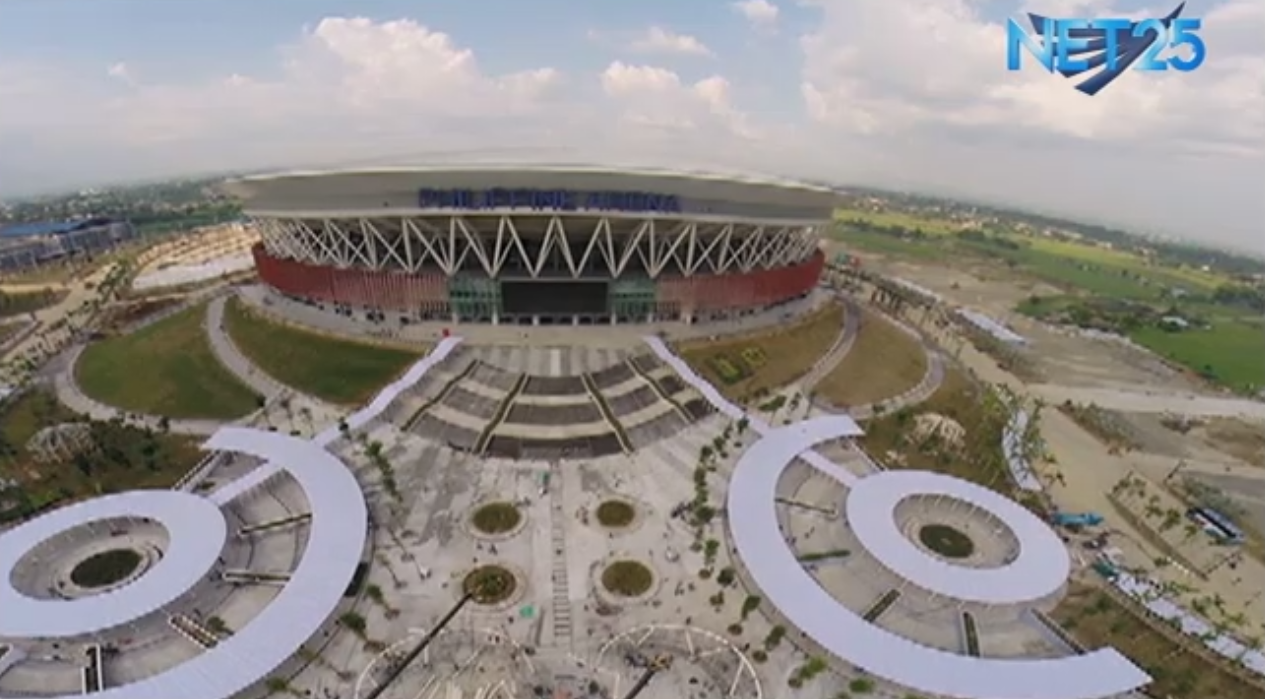 MANILA, Philippines – The 55,000 seater “mighty” Philippine Arena, dubbed as the “world’s largest indoor domed arena” is to be inaugurated today, July 21, eventually placing the Philippines among the countries with notable modern architectural marvels. The arena will be inaugurated along with the Ciudad de Victoria (or City of Victory) of the Iglesia Ni Cristo in Bulacan, in time for the July 27 centennial celebration of one of the fastest-growing Chistian churches in the world, the Iglesia Ni Cristo or Church of Christ.
MANILA, Philippines – The 55,000 seater “mighty” Philippine Arena, dubbed as the “world’s largest indoor domed arena” is to be inaugurated today, July 21, eventually placing the Philippines among the countries with notable modern architectural marvels. The arena will be inaugurated along with the Ciudad de Victoria (or City of Victory) of the Iglesia Ni Cristo in Bulacan, in time for the July 27 centennial celebration of one of the fastest-growing Chistian churches in the world, the Iglesia Ni Cristo or Church of Christ.
The Philippine Arena and Ciudad de Victoria is the centerpiece of the many centennial projects of the Church, the growth of which had been described as phenomenal by observers. From a handful of members when it was registered in the Philippines on July 27, 1914, the Iglesia Ni Cristo has now expanded to more than 100 countries.
Its members now come from 110 races around the world, scattered across six continents “The opening of the Philippine Arena will be right on schedule. Constructed in only three years, the Philippine Arena, so far the world’s largest multi-purpose domed arena will officially open its doors to the public on Monday, July 21, 2014, in time for the Iglesia Ni Cristo,’s Centennial Celebration,” an INC press statement read.
INC Executive Minister Bro. Eduardo V. Manalo will lead the unveiling of the marker for the entire Ciudad de Victoria 50-hectare complex, developed and built by the Church through its registered educational institution, the New Era University. About 140 hectares in total land area have been acquired in Bocaue and Sta. Maria in Bulacan for the future expansion of the tourism enterprise.
The Iglesia Ni Cristo said only voluntary offerings from its members caused the construction of the Philippine Arena, an architectural marvel that had been already featured by the Discovery Channel in December 2013. “This is the largest theater on the planet,” said INC General Auditor Glicerio B. Santos Jr. “This was built not only for the members of the Iglesia Ni Cristo, but for all the people. Kaya nga natin tinawag na Philippine Arena. Kung pag-aari man ng Iglesia ito, ang makikinabang, ang Pilipino (That is why it is called Philippine Arena. Even if this is owned by the Iglesia Ni Cristo, Filipinos will benefit from it),” he said.
He said that what will be inaugurated on Monday, July 21, will not only be the Philippine Arena, but the whole Ciudad de Victoria complex, where two other massive structures stand: the Philippine Stadium and the Philippine Sports Center. The Philippine Arena was designed and built to withstand strong earthquakes and super-typhoon winds, and has in fact withstood the 150 to 185 kilometers per hour winds of typhoon Glenda (international name Rammasun) that slammed Metro Manila and nearby provinces, including Bulacan, on Wednesday, July 16.
The Philippine Arena’s design was inspired by the narra tree (the Philippine’s national tree) and the root of the banyan tree with a dome spanning over 3.6 hectares. It has been hailed as a modern marvel of architecture and engineering. Populous, one of the largest architecture firms in the world, was responsible for the Philippine Arena’s concept design.
Populous is an architectural firm specializing in the design of sports facilities and convention centers as well as planning of major social events. It has designed sports stadiums and arenas all over the world, including such globally prominent facilities as the new Yankee Stadium in New York, Wembley Stadium in London, Stadium Australia in Sydney, Wimbledon Centre Court, Minneapolis’ Target Field, San Francisco’s AT&T Park, Chicago’s United Center arena, Busch Stadium in St. Louis, Great American Ball Park in Cincinnati, Pittsburgh’s Heinz Field, Houston’s Reliant Stadium, Arsenal’s Emirates Stadium, and now the Philippine Arena in Bulacan. Populous, in its website said, “the new Philippine Arena pushed the boundaries of Arena design.” “This vast scale creates technical challenges, especially as it is a one-sided bowl.
It is difficult to have 50,000 people with one focal point, give everyone a good view and create a sense of atmosphere. The tight compact bowl shape helps achieve this with its saddle bowl form, high in the centre and dropping at the flanks. Strategically placed video boards also help with atmosphere and provide additional viewing,” it said.
Populous said the Arena’s capacity was its challenge. It had been master planned to enable 50,000 people to gather inside the building and a further 50,000 to gather at a ‘live site’ outside to share in major events, it said. “Another challenge is to retain intimacy and make sure the arena never feels empty. The lower bowl will be the most frequently used part of the building and the design allows for easy separation of the lower bowl from the upper tier, by curtaining with acoustic and thermal properties. “ “The building has also been designed to cope with large numbers arriving for an event simultaneously.
People will be redirected immediately they enter the front door to avoid major circulation build ups,” Populous explained. The arena will not only hold major church gatherings, it will also operate as a multi-use sports and concert venue, capable of holding a range of events from boxing and basketball to live music performances. There are clear sightlines from every seat on each tier, even for various arena configurations such as church ceremonies, boxing, tennis, concerts or indoor gymnastics.
Inside the Philippine Arena, there is a clear “line of sight” for every seat from each tier, even for various arena configurations such as church ceremonies, boxing, tennis, concerts or indoor gymnastics. The whole arena will also be completely air-conditioned. Buro Happold, a British professional services firm, did the structural engineering of the arena, while the Korean firm, Hanwha Engineering & Construction, was the construction firm that completed the project.
Soon, the Iglesia Ni Cristo will also cause the construction of an 11-story 1,000-bed hospital, the Erano G. Manalo Medical Center, and the New Era Sports Academy of the New Era University, in the vast Ciudad de Victoria. The INC has contracted the multi-awarded PWP Landscape Architecture to do the site development of Ciudad de Victoria, particularly the areas surrounding the Philippine Arena.
PWP Landscape Architecture did the landscape of the National September 11 Memorial Museum (also known as the 9/11 Memorial and 9/11 Museum) in New York which was built to commemorate the September 11 attacks of 2001 in the United States. INC Executive Minister Eduardo V. Manalo led the groundbreaking ceremony of Ciudad de Victoria and announced the construction of the Philippine Arena in August 2011.







